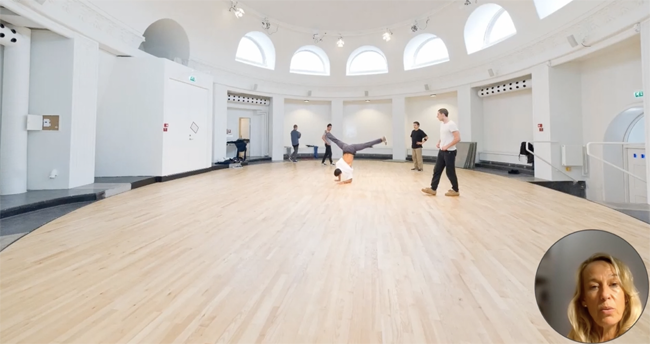Author: Marte Dorothea Marstrand, Project Leader, Tverga
On 27 September 2024, IAKS Nordic teamed up with Tverga and brought together experts and practitioners from Denmark and Norway to discuss the exciting potential of transforming old spaces into dynamic facilities for sports and culture. Over 300 participants from around the globe tuned in to explore how we can breathe new life into existing structures and help reduce our environmental footprint.
The recording is available for IAKS members to watch at no additional charges. Simply ask for your access code at info@iaks.sport
In an era when sustainability is paramount, why construct new sports facilities when we can repurpose existing buildings? This question was at the heart of the webinar’s discussions. Building new facilities not only comes with high financial costs but also significant CO2 emissions, complicating efforts to meet climate goals like those outlined in the Paris Agreement. In Norway, the trend towards constructing new sports and cultural buildings remains strong, but an increasing emphasis is being placed on reusing what already exists to combat climate change.

Sina Jenhaug Ringlund, Kristin Braut, Mie Fuglseth, Lisa Mari Watson (f.l.t.r.)
A vital strategy for a sustainable future

Lisa Mari Watson, General Manager of Tverga in Norway, opened the webinar with a compelling argument for prioritizing transformation. She highlighted startling statistics from Statistics Norway (SSB): approximately 4,500 large buildings are constructed annually, while 3,300 are demolished. Meanwhile, 157 new sports facilities are built each year in Norway, yet there is a lack of focus on transforming old spaces for modern use. Lisa Mari emphasized that by 2050, 80-90% of Norway's current building stock will still be standing, which makes transformation a vital strategy for a sustainable future.
She also drew attention to the limitations of the National Lottery Fund, Norway’s primary funding source for sports facilities. Despite allocating EUR 164 million annually to such projects, the fund’s strict criteria hinder innovation, particularly in terms of prioritizing sustainability through renovation and repurposing.
Think twice before demolishing

Mie Fuglseth, Senior Advisor on Climate and Materials at the Green Building Alliance Norway, tackled a common misconception: that repurposing old buildings is always more expensive and complex than building from scratch. She pointed out that hundreds of warehouses and industrial spaces are demolished in Norway, yet many of these could be revitalized, for example for sports purposes. Mie encouraged participants to focus on the benefits of transformation - lower environmental impacts, cost savings, and the preservation of local history and identity.
For further research on this subject take a look at the
Fysak Åsane: From old sports hall to innovative multi-purpose hall for self-organized sports
Kurt Forsberg, Manager of the Sports Department for Bergen Municipality, showcased the success of the FYSAK centers, innovative facilities for lifestyle sports, often built through the transformation of existing spaces. A prime example is FYSAK Åsane, where an old sports hall has been reimagined as a versatile, multi-purpose facility that meets the needs of diverse user groups.
The traditional school gymnasium – Revitalizing the most common and underused indoor sports facility in Denmark

Across the border in Denmark, the Danish Foundation for Culture and Sports Facilities is breathing new life into traditional school gymnasiums. Oliver Vanges, a Development Consultant with the foundation, shared how they’ve revitalized these old spaces, demonstrating that traditional school gymnasiums can be transformed into modern, dynamic environments for physical activity.
Read more about the project:
Oslo's bold climate strategy

Sina Jenhaug Ringlund, a Climate Advisor for the City of Oslo, outlined the city's ambitious climate goals: reducing greenhouse gas emissions by 95% by 2030, compared to 2009 levels. A key part of Oslo’s strategy is avoiding the demolition of existing buildings, favouring the highest degree of reuse possible. The Planning and Building Agency (PBE) has developed a set of climate criteria for use in planning and building regulations, stating that one should always “Avoid the demolition of existing buildings and promote the highest possible degree of reuse.”
Read more about
Transformation – How to achieve good processes?

Kristin Braut, Head of Transformation at Rodeo Architects, provided insight into the architecture firm’s approach to adaptive reuse. Rodeo has repurposed its own office space and applies the same principles in many of its projects. Kristin emphasized that transformation is about honoring the history of a building while addressing future needs. The process, she explained, begins with careful analysis, user participation, and a commitment to flexibility, ensuring that both the building and its context are fully understood before making changes.
Streetmekka and dance chapel: Inspiring examples from Denmark
The webinar concluded with two standout projects from Denmark:
These projects creatively reimagine existing buildings, preserving their history while transforming them into vibrant, multifunctional spaces that inspire and engage the community.




